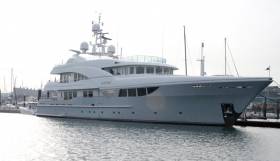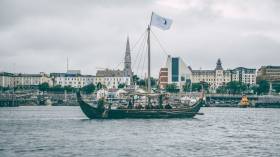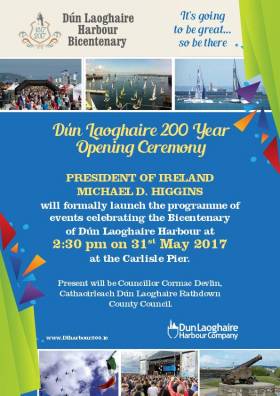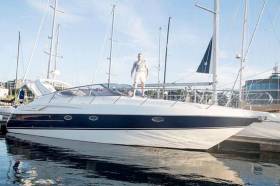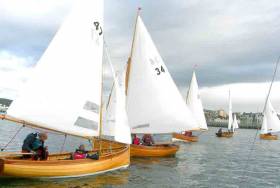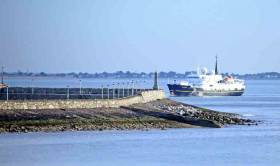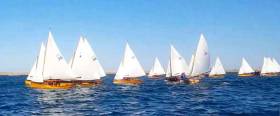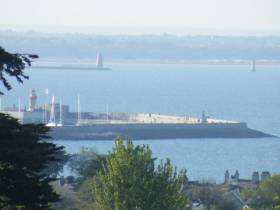Displaying items by tag: Dun Laoghaire Harbour
#Superyachts - All indications show the superyacht market is turning around — and as it expands, it’s important to note that more and more of these vessels are eschewing crowded Mediterranean spots and cruising instead in Northern European waters.
Typically these luxury craft, many greater than 50 metres in length, are heading to northern destinations such as the Orkney Islands, Norway and Sweden that are already popular with cruise liners.
On the way, they’re transiting the Irish Sea — and seeking opportunities for safe and convenient berths close to transport links in the UK and Ireland alike. Dun Laoghaire is perfectly positioned to capitalise on this market.
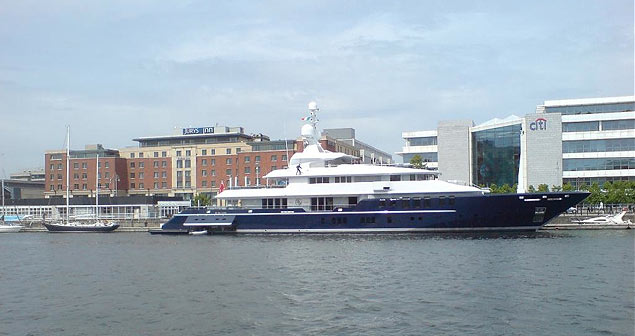 The completion of the Samuel Beckett Bridge across the River Liffey in Dublin City effectively meant the demise of the Dublin City Mooring facility in 2010 as large craft could no longer transit the river. During their relatively short period of operation, the modest Dublin City Mooring pontoons in the heart of Dublin was able to attract a number of superyachts (like the Triple 7 above) to berth on their pontoon which was located conveniently in the heart of Dublin. This is no longer possible and has effectively ended Dublin as a destination for visiting superyachts but these superyachts still want to come here
The completion of the Samuel Beckett Bridge across the River Liffey in Dublin City effectively meant the demise of the Dublin City Mooring facility in 2010 as large craft could no longer transit the river. During their relatively short period of operation, the modest Dublin City Mooring pontoons in the heart of Dublin was able to attract a number of superyachts (like the Triple 7 above) to berth on their pontoon which was located conveniently in the heart of Dublin. This is no longer possible and has effectively ended Dublin as a destination for visiting superyachts but these superyachts still want to come here
Above and beyond the local spend on overnight berths, and victualling these superyachts, there are significant opportunities to target high net worth individuals in the luxury tourism market. And Dublin is a recognised go-to destination.
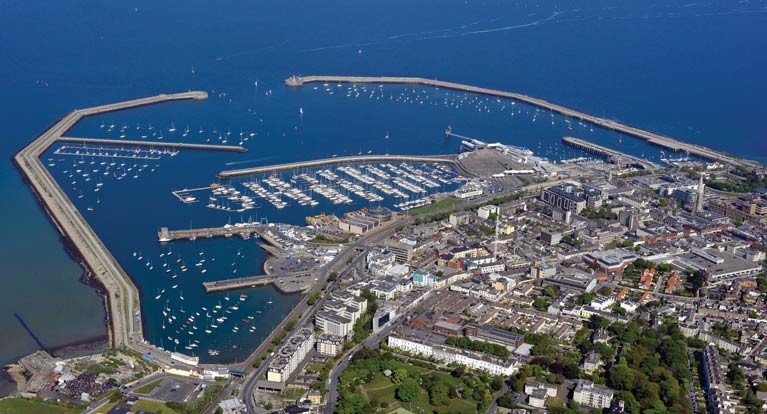 The Dun Laoghaire Harbour Company is currently marketing the harbour as a cruise ship destination in competition to the existing location of Dublin Port. It is seeking to establish the harbour as a stop over for small to medium sized cruise ships and has identified the Carlisle Pier for this purpose. Super yachts can also be accomodated in this plan. Photo: Michael Chester
The Dun Laoghaire Harbour Company is currently marketing the harbour as a cruise ship destination in competition to the existing location of Dublin Port. It is seeking to establish the harbour as a stop over for small to medium sized cruise ships and has identified the Carlisle Pier for this purpose. Super yachts can also be accomodated in this plan. Photo: Michael Chester
Many of these superyachts are the size of small ships, weighing over 250 tonnes. It means they’re too big for Dun Laoghaire’s 800–berth yachting marina, but they represent a welcome boon for a harbour vacant since the loss of the Stena HSS ferry service. One recent arrival into Dun Laoghaire was the magnificent Atlantic schooner from America in August. Read Aflaot.ie's article on the Atlantic's visit here.
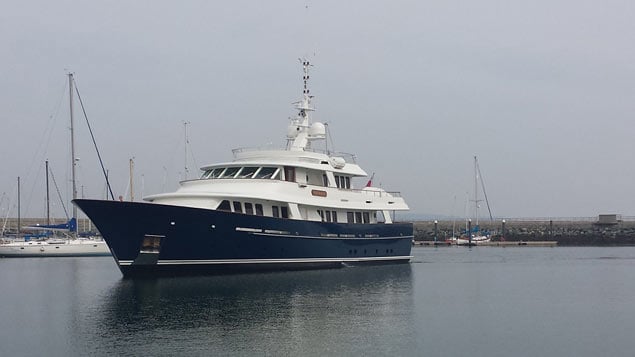 The 35.80m Arcadia berthed in Dun Laoghaire in September 2014. Not only does the impressive 'Arcadia' have gorgeous lines but as the 159th vessel to transit the Northwest Passage, she's also a serious long distance expedition motor yacht too
The 35.80m Arcadia berthed in Dun Laoghaire in September 2014. Not only does the impressive 'Arcadia' have gorgeous lines but as the 159th vessel to transit the Northwest Passage, she's also a serious long distance expedition motor yacht too
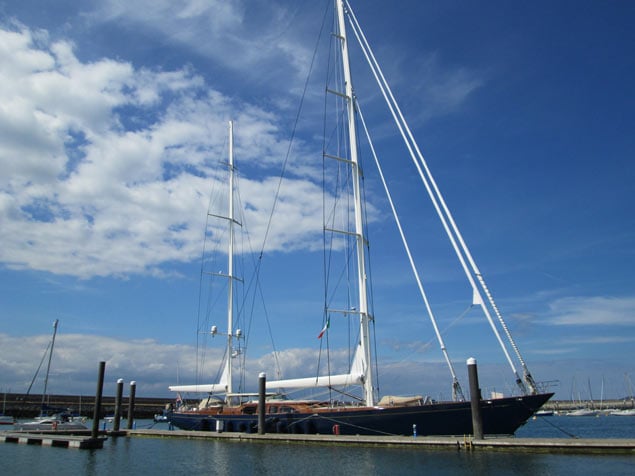 Even seasoned observers were gobsmacked at the sheer size of the 46–metre (150–foot) Superyacht Christopher berthed at Dun Laoghaire marina in 2014, dwarfing all 500 local craft in the harbour. Christopher represents the upper limit of craft permitted at the marina due to weight and draft restrictions. In fact Christoper could only be facilitated in the marina due to the fact she has a lifting keel
Even seasoned observers were gobsmacked at the sheer size of the 46–metre (150–foot) Superyacht Christopher berthed at Dun Laoghaire marina in 2014, dwarfing all 500 local craft in the harbour. Christopher represents the upper limit of craft permitted at the marina due to weight and draft restrictions. In fact Christoper could only be facilitated in the marina due to the fact she has a lifting keel
What's more thanks to the Failte Ireland accredited marina, it has the type of 'concierge' facilities to deal with visiting superyachts: everything from car hire to hotel bookings.
But this isn't an overture for billionaires who have no place to park their superyacht. There's a business case to say that Dun Laoghaire town can easily take advantage of this.
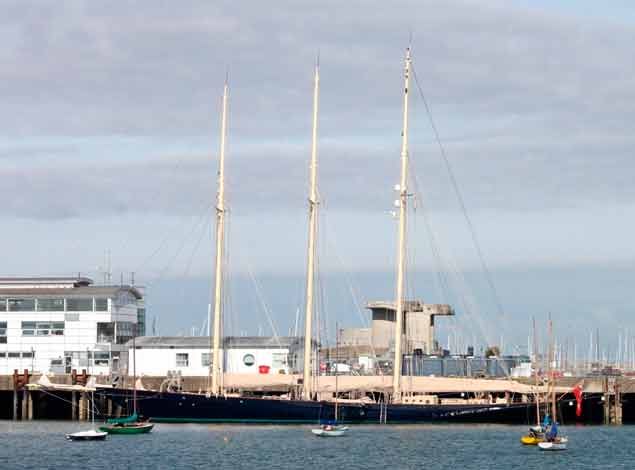 The two-year-old 185–ft three-masted schooner Atlantic alongside at Dun laoghaire Harbour in August. The replica that was too big for the yachting marina stayed for a week at a secure but somewhat neglected (below) berth No.4 alongside at the abandoned ferry terminal. Photos: Twitter
The two-year-old 185–ft three-masted schooner Atlantic alongside at Dun laoghaire Harbour in August. The replica that was too big for the yachting marina stayed for a week at a secure but somewhat neglected (below) berth No.4 alongside at the abandoned ferry terminal. Photos: Twitter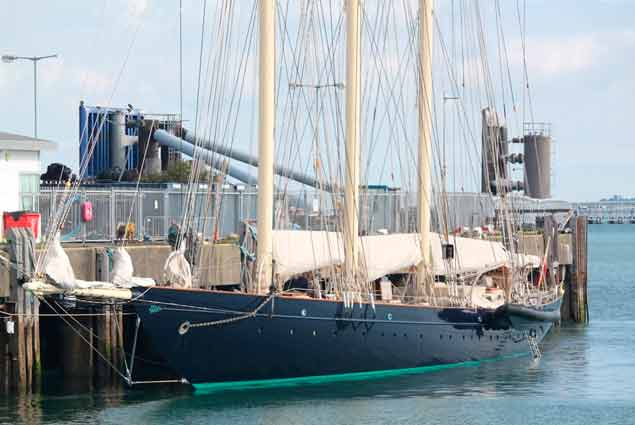 The facilities required to operate a Super yacht berth amenity are relatively few. A serviced, heavy duty linear concrete pontoon of approximately 80–100m length with shore access via a bridge. Secure access by crew, guests and staff only. Crew facilities could be located in the ferry terminal and be accessible 24 hours to include toilet and shower facilities and wifi access. There is an existing level of security infrastructure which would be utilised including CCTV and Harbour Police to give added assurance to crew and guests that their boat will be secure at all times
The facilities required to operate a Super yacht berth amenity are relatively few. A serviced, heavy duty linear concrete pontoon of approximately 80–100m length with shore access via a bridge. Secure access by crew, guests and staff only. Crew facilities could be located in the ferry terminal and be accessible 24 hours to include toilet and shower facilities and wifi access. There is an existing level of security infrastructure which would be utilised including CCTV and Harbour Police to give added assurance to crew and guests that their boat will be secure at all times
At a time when nothing seems to be going right for Dun Laoghaire, these boats could be an important part in the mix of rejuvenating the harbour, bringing much needed revenues — and a splash of glamour.
They’re coming here already, but more could be done to market Dun Laoghaire as a superyacht destination that could even see the harbour as a winter lay-up hub, too.
To attract them would not need consultants, planning permission, investment, tenders — just the space they need. And that’s already available in Dun Laoghaire, which has four vacant ship berths capable of accommodating such vessels.
The question isn’t whether Dun Laoghaire can attract this lucrative superyacht business — the question is, who in the harbour will take the initiative?
 Source: Towergate Insurance
Source: Towergate Insurance
Battle of Dun Laoghaire Harbour Fought By INSS Viking Invaders
Out of the mist and rain came waterborne Vikings to battle on Dun Laoghaire's East Pier yesterday afternoon. The Irish National Sailing School (INSS) co-ordinated a free and family–friendly event that featured battles, longboats and a Viking village from 12-5pm.
Like a thousand years ago, the marauding did not commence on time. Downpours, however, did not deter an impressive crowd of hundreds, huddled together at the town's bandstand. By battle–time there was a steady stream of people on the pier's top level. Some locals even took it upon themselves to intercourse with invaders. Others were more focussed on the fight.
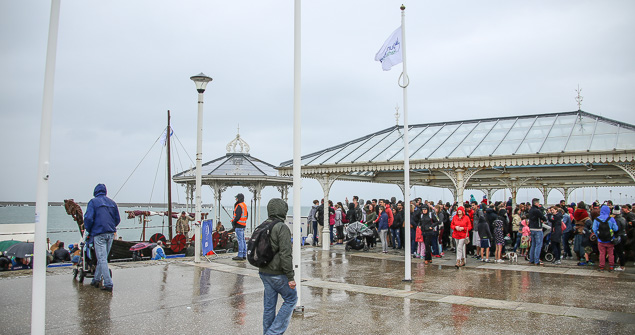 Local forces take shelter Photo: Afloat.ie
Local forces take shelter Photo: Afloat.ie
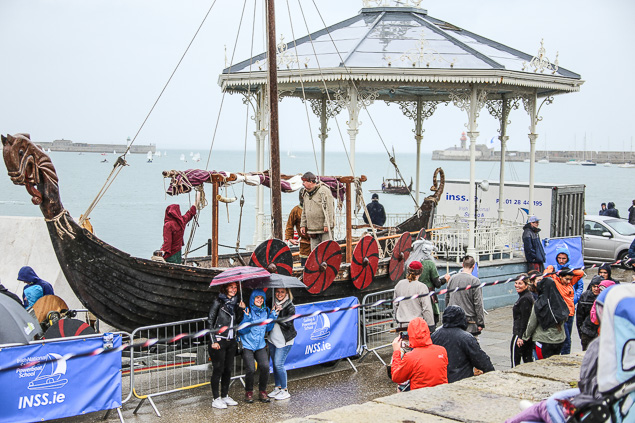 Taking time for some Viking selfies before battle commences Photo: Afloat.ie
Taking time for some Viking selfies before battle commences Photo: Afloat.ie
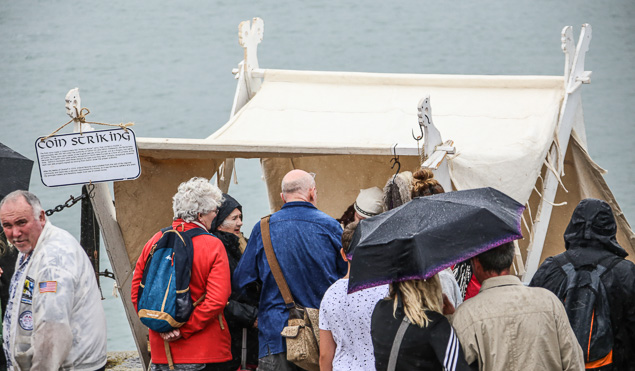 The Norsemen soon set up shop Photo: Afloat.ie
The Norsemen soon set up shop Photo: Afloat.ie
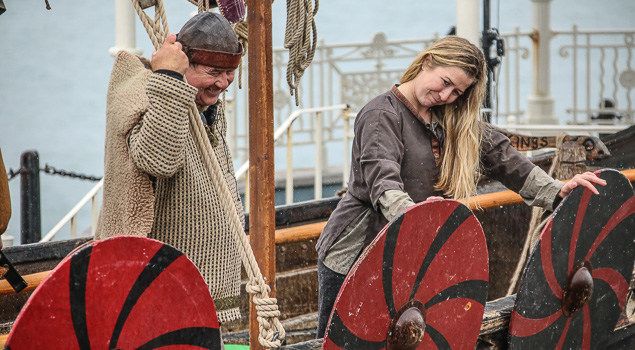 Some were friendly....Photo: Afloat.ie
Some were friendly....Photo: Afloat.ie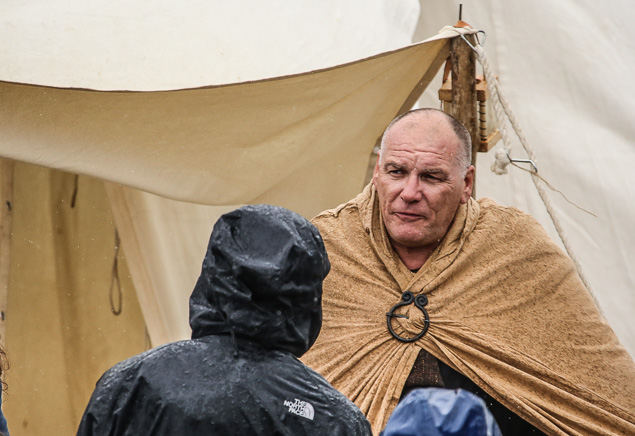 others maybe not so much...Photo: Afloat.ie
others maybe not so much...Photo: Afloat.ie
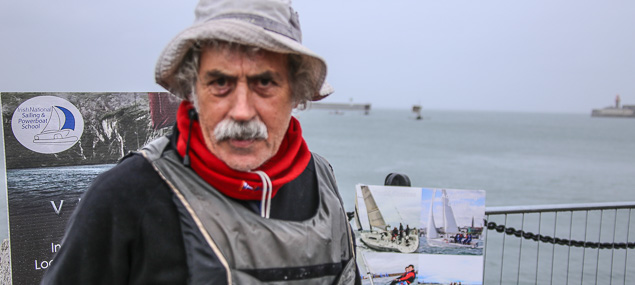 INSS's Alistair Rumball prepares for battle as Viking longships approach from the harbour mouth Photo: Afloat.ie
INSS's Alistair Rumball prepares for battle as Viking longships approach from the harbour mouth Photo: Afloat.ie
INSS's Alistair Rumball, who provides Marine Film Location Services to the hit TV series Vikings, has been blamed for the Norse incursion.
His unlikely alliance with harbour forces including, King of Dun Laoghaire Harbour Gerry Dunne, led to the pitting of seafarers versus townspeople on the occasion of the harbour's bicentenary.
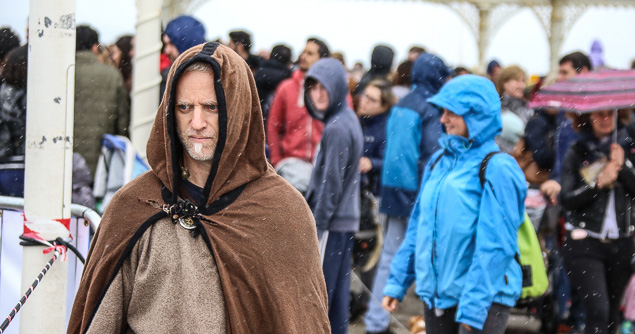 The Irish summer was no deterrent to the planned invasion Photo: Afloat.ie
The Irish summer was no deterrent to the planned invasion Photo: Afloat.ie
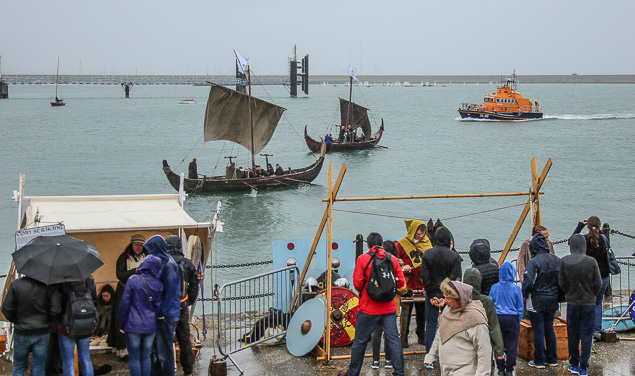 Not even the local lifeboat could stop it...Photo: Afloat.ie
Not even the local lifeboat could stop it...Photo: Afloat.ie
The onset of bad weather though, meant the Vikings, who approached under oar and sail, arrived early at the harbour mouth (Battle of Clontarf, here we go again) and Chief Rumball decreed battle should commence by 2pm.
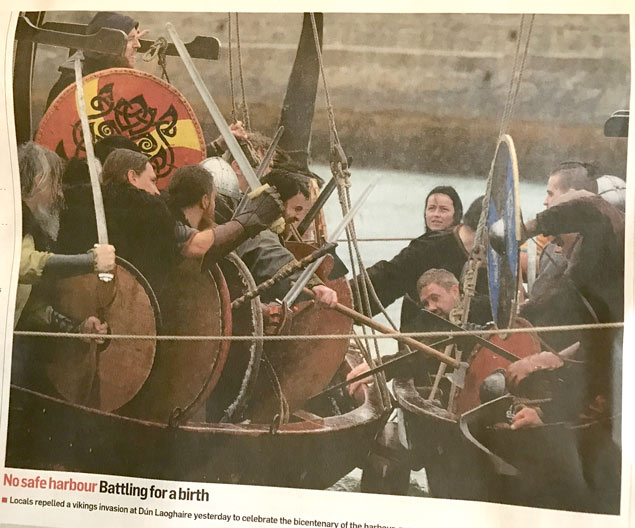 Making the press: Dun Laoghaire's Viking battle hit the headlines, including this fine photograph in this morning's Irish Times
Making the press: Dun Laoghaire's Viking battle hit the headlines, including this fine photograph in this morning's Irish Times
The battle was shorter than in Clontarf's sunrise to sunset exaggerated affair, but ended all the same in a rout of the Leinster forces that was witnessed by the High Chief of Leinster, Mary Mitchell O'Connor TD, Minister of State at the Department of Education.
The Viking contingent led by Sigurd Stena Line of Orkney and Brodir Irish Ferries of Mann were soon back in charge of the Piers – to the relief of many.
#HarbourTours – Following the recent visit of President Michael D Higgins to launch the Dun Laoghaire Bicentenary Celebrations, guided walking tours of the harbour continue to mid-June.
The free guided walking tours will delve into the magnificent engineering of the historic harbour that began construction 200 years ago in 1817. Four years later the harbour works were inspected by King George IV and following the visit the town was renamed Kingstown in his honour.
In 1823 along the harbour waterfront, the King George IV Obelisk monument was erected and this is where President Higgins on Wednesday last had attended the commemorative ceremony.
The talks will also explain about the earlier harbour and how the present harbour was built using granite from Dalkey.
Also the tour highlights some of the lesser-known features of this wonderful harbour, that was originally planned as a 'Port of Refuge' with just a single pier, the East Pier. It was decided however to add a second pier, that been the West Pier. In total the harbour took 25 years to construct with completion finally taking place in 1842.
Tours are held every Tuesday and Thursday until 15 June and are wheelchair accessible.
Meeting point: Bridge over the Dun Laoghaire DART Line at Crofton Road.
Time: 11.00am (1 tour per day)
Duration: 1 hour
Max Capacity: 30 people
The talks are part of the Spring into Heritage (28 April-18 June) programme organised by Dun Laoghaire-Rathdown County Council. For further website information including other events (click to download brochure) that are mostly free, it is advisable to arrive early.
#DLHarbour - Here’s a reminder for your calendar that President Michael D Higgins will officiate the opening ceremony of Dun Laoghaire Harbour’s bicentenary celebration.
President Higgins will formally launch the programme of events celebrating the harbour’s 200 years — which includes July’s Volvo Dun Laoghaire Regatta — from 2.30pm this Wednesday 31 May at Carlisle Pier.
The commemoration will be followed at 3pm by a 21-gun salute from the East Battery as well as a fly-past by two Air Corps aircraft from the direction of Killiney Hill, as previously reported on Afloat.ie.
#Notorious - MMA superstar Conor McGregor swapped the UFC Octagon for a sleek motor yacht to make the most of Ireland’s recent sunny spell, as his Instagram account indicates.
McGregor drove out to Dun Laoghaire Harbour a few days ago with a pair of jet skis hitched behind his “custom built” SUV to mess about on his latest extravagant purchase, a motorboat he’s named The 188 in a wry reference to the weekly Jobseekers Benefit.
True to his cheeky form, McGregor dismissed his new vessels as “summer toys” and jokingly offered: “Anyone wanna buy a yacht and a few skis hahaha [sic]”.
While the sun might be hidden again for a few days, Ireland is bound to get another mini-heatwave that will surely bring the ‘Notorious’ one back to Dun Laoghaire for more cruising in his inimitable style.
Two hundred years after the foundation stone was laid to build Dun Laoghaire Harbour, the President Michael D Higgins, accompanied by his wife Sabina, will officiate at the Bicentenary opening ceremony at 14:30 on Wed 31st May 2017, at the King George IV monument in Dun Laoghaire harbour.
In May 1817, the Lord Lieutenant of Ireland, Earl Whitworth, laid the foundation stone, the first stone from the quarry at Dalkey, on the site where the King George IV monument on Queens Road was subsequently built. On that day, Lord Whitworth, included with the foundation stone, a time capsule which included a coin of the realm and ten newspapers.
In the Bicentenary opening ceremony, to mark this special occasion two hundred years later, His Excellency, President Michael D Higgins, will place a new time capsule at the King George IV monument. This time capsule will include drawings from local school children, a newspaper of the day, recent photographs of the harbour, and letters from the RNLI, Coast Guard, Coal Harbour Users Group and An Cathaoirleach.
As part of the ceremony on May 31st next, the Air Corps will undertake a “Fly By”, ceremonial cannons will be fired, and a 21 Gun Salute will be accorded by the Irish Defence Forces to mark the occasion. Volunteers from the RNLI and the Coast Guard will create a guard of Honour to welcome the President.
The ceremony will also announce the packed summer schedule of events marking the Bicentenary of Dun Laoghaire harbour, taking place around Dun Laoghaire throughout the rest of the year.
Yesterday evening the Water Wags raced for the Buckingham Cup & Wigham Trophy with handicaps applied at the start, resulting in some boats starting five and a half minutes ahead of others. The handicaps were allocated on the basis of average finishing places in the three championship races held to date. At the time when the first boats started, there was almost no wind in that part of the harbour, and the course was laid for the expected wind from the east, and there was much congestion and dirty wind in the starting line area. The start guns sounded at approximately one minute intervals, but due to lack of wind many boats failed to start on their allocated times.
At the first mark, Paul & Anne Smith in Sara led from Ben McCormack in Marcia and Nandor with Brian Mc Bride and Stuart McBean sailing in 5 knots of wind. These three managed to escape the wallowing at the start area, and built up a huge lead. On the downwind legs, there was much effective blanketing in the following fleet caused by spinnakers of the following boats.
On the final beat, a large black cloud was building up over Dublin City. Eventually, the wind caused by this cloud revealed itself as a strong southerly wind of about 12 knots which hit some of the fleet with such a surprise, that a few boats nearly capsized.
At the finish the order was:
1st – 30, Sara, Paul & Anne Smith.
2nd - 45, Mariposa.
Cathy MacAleavey & Con Murphy
3rd.-33, Eva,
Orla Fitzgerald & Katie Tingle.
4th. 38, Swift, Guy & Jackie Kilroy
5th. - 44, Scallywag. Dan O’Connor & David Williams
6th. -15, Moosmie, David MacFarland.
7th. - Skee, Jonathan & Carol O’Rourke.
8th. - 31, Polly. Richard Mossop and Henry Rooke.
9th. – 46, Mademoiselle.
10th. –37, Marcia.
11th- 36, Little Tern.
12th. – 41, Mollie.
13th. -42, Tortoise,
14th. – 16, Penelope.
15th. - 18, Good Hope.
16th. -3, Pansy,
17th. – 4, Vela.
18th. – 40, Swallow.
19th. -43, Freddie.
20th. -47, Peggy.
21st. -20, Badger.
22nd. –26, Nandor.
23rd. -17, Coquette,
24th. -10, Sprite,
25th. - 34, Chloe,.
26th. -6, Mary Kate
Luxury Cruise Ship 'Serenissima' Arrives at Dun Laoghaire, The First of Eight Liner Visits For Harbour Town This Summer
The arrival of the five star luxury cruise ship Serenissima into Dun Laoghaire this morning kicks off the town's summer cruise-liner visits this morning.
Weighing in at over 2,500 tonnes, the Serenissima is the length of a soccer pitch, has 59 cabins and a passenger and crew complement of 160 people, will call today, allowing its passengers and crew take in the sights of Dun Laoghaire and surrounds.
Welcoming the ship into Dun Laoghaire, Carolyn Hanaphy of Dun Laoghaire Harbour Company said today that “the Serenissima is the first of 8 cruise ship visits scheduled for Dun Laoghaire this summer, bringing with them nearly 3,000 passengers and crew into the town. We are always delighted to see these ships come to our town and spend some time here. Each of these ships is welcomed alongside the historic Carlisle Pier leaving disembarking passengers and crew just 500 metres from the town centre where they can enjoy all that Dun Laoghaire offers in terms of hospitality, shopping and good restaurants and pubs all within a short stroll from the ship.”
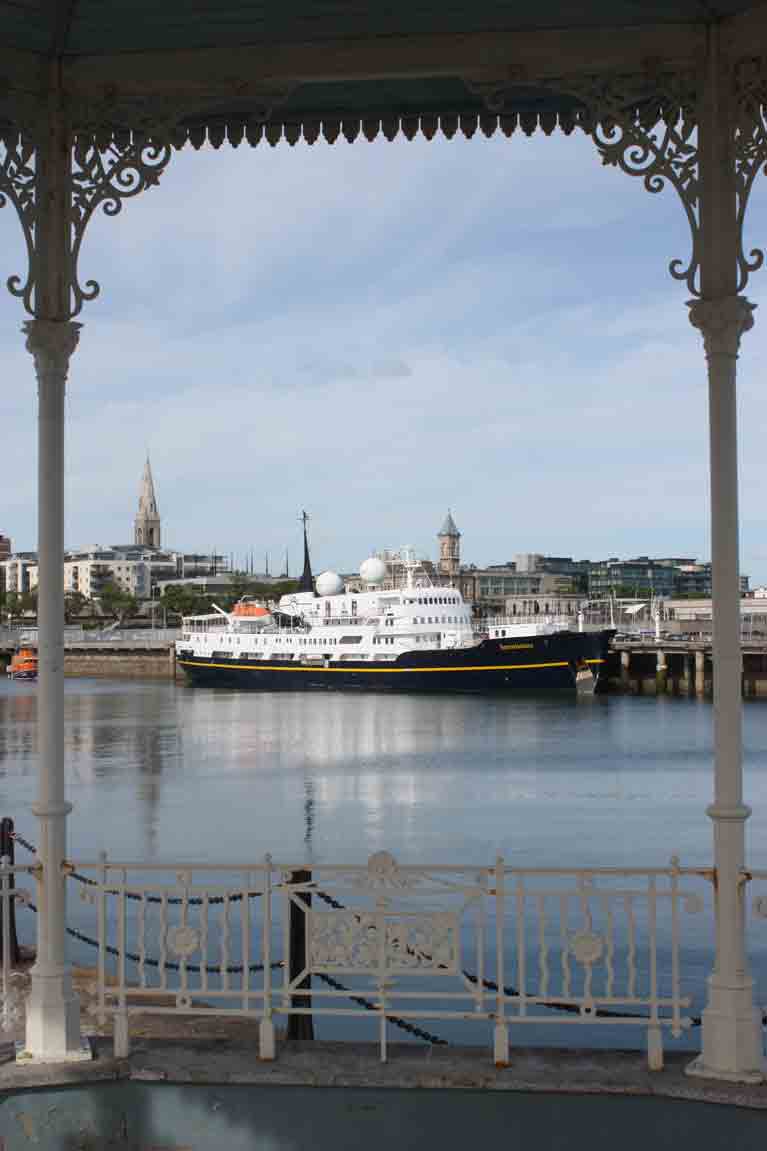 Cruise ship 'Serenissima' berthed at the Carlisle Pier in Dun Laoghaire
Cruise ship 'Serenissima' berthed at the Carlisle Pier in Dun Laoghaire
Dun Laoghaire Harbour Master Capt. Simon Coate today said that “Dun Laoghaire Harbour Company work hard to secure luxury ships of this kind to come and visit our harbour. The Serenissima which will stop off on her way around the “Gardens of the British Isles” is a charming vessel with a unique style. During a major refit the owners commissioned Swedish interior designers to create an 18th century influenced Gustavian style interior. The unique style and grandeur of this vessel certainly is in keeping with the unique aesthetics of our 200-year-old harbour, making Dun Laoghaire a sought-after port of call on her voyage.”
The ship is on a 12-day cruise of the “Gardens of the British Isles”. She left Portsmouth 7 days ago and has already made numerous stops along the English coast, has stopped off in Bantry Bay to visit Garnish Island and Waterford and now she is calling to Dun Laoghaire to visit Powerscourt Gardens. The ship will continue onto Wales, Northern Ireland and Scotland on route to her final destination in Oban in Scotland.
'Moosmie' Leads Water Wag Series (Start Video Here!)
For the second week in a row, the wind in Dun Laoghaire blew from the north. This time the wind of 12 -15 knots kicked up quite a chop within the harbour, which some competitors found challenging. In the130th season for the class, twenty-three Water Wags turned up for the second of three matches for The Newsom Memorial Cup (div. 1A), Hilpotsteiner Tankard (div 1B), and Phyllis Cup (div. 2).
At the start, many Wags found themselves behind the committee boat at the starboard end of the start line. No so, Barbara, Pansy, Moosmie and Mary Kate who hit the line perfectly. It turned out that tide would not be a significant factor in the race, but due to a small bias in the start line, it did pay to start at the starboard end of the line. Start video courtesy of Jenifer Hudson below:
Due to the size of the waves coming through the harbour mouth, crews had to work had to keep momentum in their Water Wags, and to minimise heeling. At the second windward mark, close to the harbour mouth the order was Moosmie, Barbara, Swift, and Tortoise. However, when Tortoise gybed soon afterwards, the helmsman slipped, and the inevitable result was water pouring over the leeward gunwale. Once spinnakers were hoisted and set they provided additional stability to the Wags, and the ability to surf the waves. On the following round the order had changed to Moosmie, Swift, and Barbara. Competitors were getting more used to the conditions after that with fewer place changes.
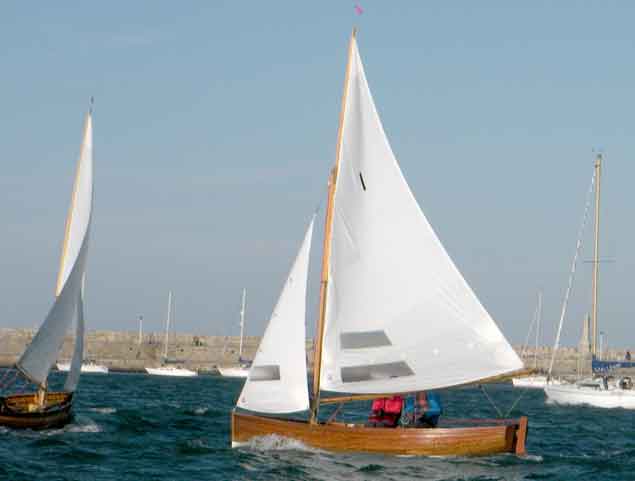 David MacFarlane in Moosmie, is the winner of both races of the series
David MacFarlane in Moosmie, is the winner of both races of the series
At the finish the order was:
1st – 15, Moosmie, David MacFarlane.
2nd - 38, Swift, Guy & Jackie Kilroy.
3rd. - 41, Mollie, Annalise Murphy.
4th. -33, Eva, Dermot O’Flynn
5th - 8, Barbara, Ian and Judith Malcolm
6th. - 3, Pansy, Vincent Delany & Charles Pearson.
7th. – 6, Mary Kate, Ian & Jenny Magowan. (Winner div 2).
8th. – 4, Vela, Philip & Katie Mayne.
9th. - 40, Swallow, David & Anne Clarke. (Winner div 1B).
10th. - 46, Mademoiselle.
11th. – 18, Good Hope.
12th. - 47, Peggy.
13th. - 34, Chloe.
14th. – 32, Skee.
15th. - 10, Sprite.
16th. - 31, Polly.
17th. – 26, Nandor.
18th. - 44, Scallywag.
19th. -16, Penelope.
20th. - 43, Freddie.
21st. - 45, Mariposa.
RET. – 36, Little Tern.
RET. – 42, Tortoise.
Overall Moosmie is in first place with Swift in second place with only one more race in the series. Link to the overall results here
Launch of DLR Spring into Heritage Programme of Events
#DLRHeritage - Easter is over but there’s plenty more to do with this year’s Spring into Heritage (28 April-18 June) programme organised by Dun Laoghaire-Rathdown County Council.
Beginning next Monday, the DLR Heritage programme offers a variety of events and free guided walking tours. Among them are those with direct maritime themes connected with Dun Laoghaire Harbour which this year celebrates its Bicentenary.
Given this special 200th anniversary, guided walking tours will prove to be particularly apt as they delve into the magnificent engineering of the historic harbour built using granite from nearby Dalkey. The harbour originally began with construction in 1817 of a single pier, the East Pier.
Nearby to the popular East Pier, there will be also be guided tours of the National Maritime Museum housed in the former Mariners Church located next to the DLR Lexicon Library.
On the other side of the harbour, just beyond the West Pier, there will also be tours of Seapoint Martello Tower built to defend a possible Napoleonic invasion. The stone-cut structure affords a wonderful panorama with views sweeping across Dublin Bay.
Why not take a visit to the Dalkey Castle & Heritage Centre. Tours explore and explain the 15th century medieval fortified towerhouse, where cargoes were once stored from ships that anchored in Dalkey Sound which then acted as the main port for Dublin.
Other none coastal venues including tours of historic houses set in parkland throughout the borough are available. Noting some events require pre-booking. For more details including downloadable leaflet click here.


























